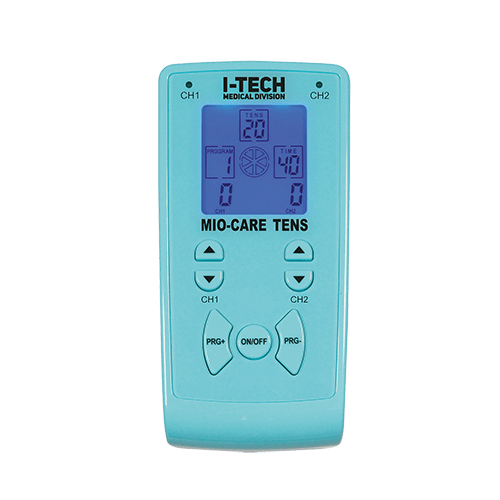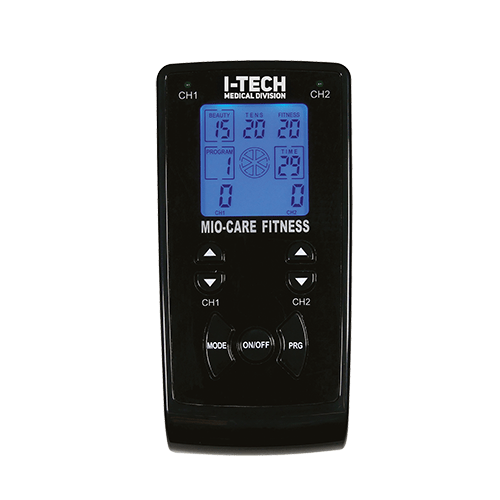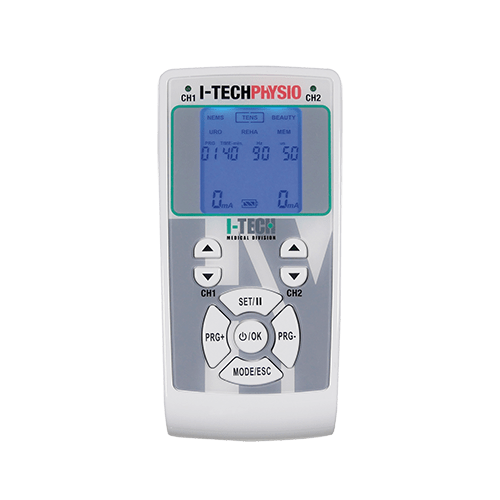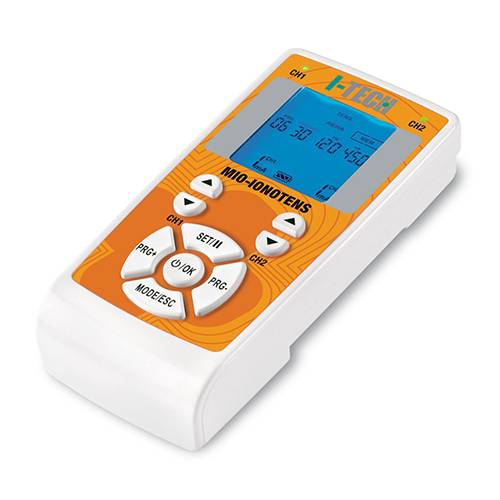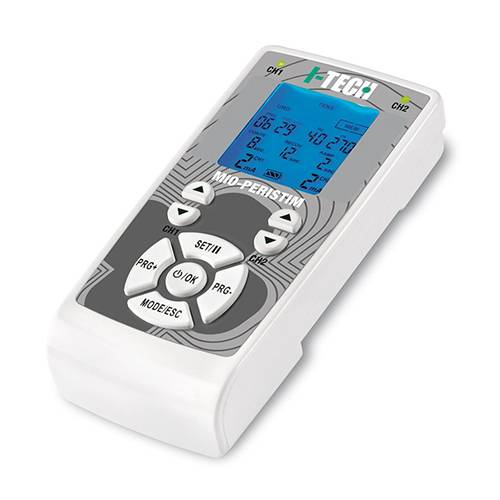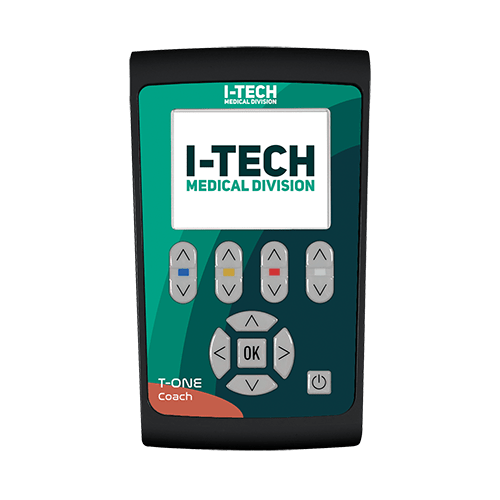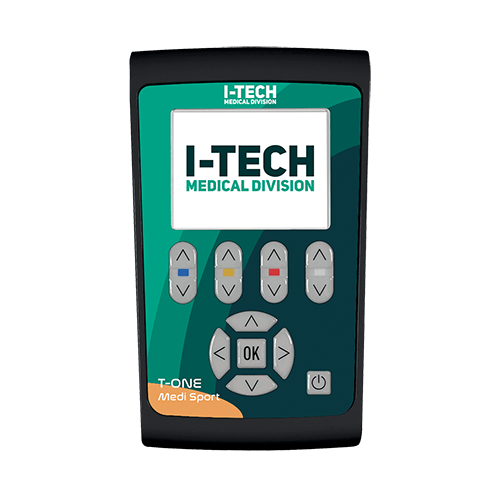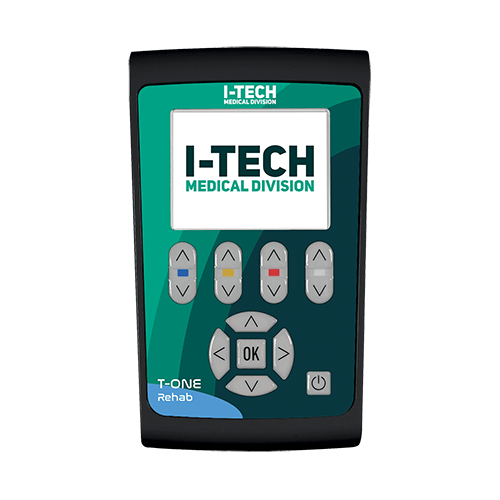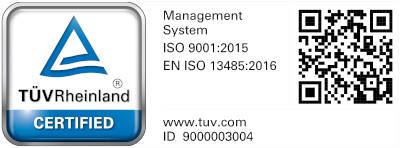- How does electrostimulation work?
- How does an electrostimulation session work
- Why use electrostimulation, and for which pathologies is it particularly recommended?
- EMS or TENS, which device should you choose?
- What are the benefits of electrostimulation?
- Are there any contraindications or side effects?
- Is electrostimulation painful?
- Electrostimulation results: before and after
- Who can use electrostimulation?
- Can electrostimulation be used to lose weight or improve sports performance?
- How can you choose the best electrostimulator for your needs?
- Do I necessarily have to choose a professional product?
- Where can you buy our electrostimulators?
It’s likely you have already heard of the word “electrostimulation” or “electrostimulator”, and that it sounds more familiar to you than many other kinds of therapies. Indeed, it is one of the oldest therapeutic techniques, and was discovered as early as 1791, by Luigi Galvani. It allows you to alleviate your perception of pain and treat numerous orthopaedic pathologies.
Furthermore, it allows you to activate and train specific muscles, as an alternative to the gym.
How does electrostimulation work?
Electrostimulation works by the same mechanism as the nervous system, with the device controlling the activation of voluntary muscles via electrical signals.
Electrostimulation can, in this way, be used to treat specific muscle groups by varying the intensity, power and different frequencies of the electrical signals.
Electrostimulation therefore, by making use of electrical pulses, replicates the voluntary action of the nervous system. And thus increases the training, anti-inflammatory treatment or rehabilitative effect on the stimulated muscles.
How does an electrostimulation session work?
An electrotherapy session is simple to perform. You just need to pay particular attention to the positioning of the electrodes according to what you are trying to achieve.
In general, if you want to carry out a treatment to relieve pain, the electrodes will need to be applied to the skin, forming a square around the area of pain.
If, however, you need to strengthen a muscle, or treat a denervated one, the electrodes should be positioned at the ends of the muscle fascia.
Finally, for transdermal drug delivery (iontophoresis), rubber sponges and electrodes are used. Once the electrodes have been inserted inside the sponges, they should be placed on the sides of the joint you need to treat.
Then, the intensity of the current should be increased without ever exceeding the pain threshold.
Before starting the treatment and positioning the electrodes, always remember to clean the area to be treated. In case of excessively hairy patches of skin, we recommend shaving the area in order to allow better contact with the electrode.
The duration of an electrotherapy session will vary according to the programme you are following, and the area and pathology to be treated.
For muscle stimulation programmes, a session will last approximately 20 minutes per muscle group. This means that if you want to use an electrostimulator on your buttocks and abdominals, for example, the entire session will last a total of about 40 minutes.
While, if you need to treat localized pain, the time may vary from 30 to 40 minutes depending on the pathology to be treated and the intensity of the electrical pulses. For this reason, we always recommend you consult your doctor for an accurate diagnosis and adequate therapeutic indications.
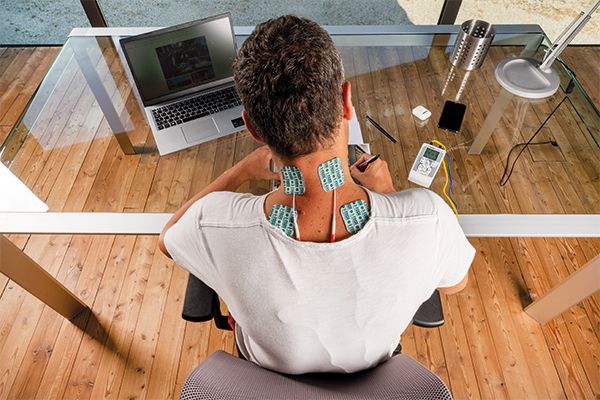
Why use electrostimulation, and for which pathologies is it particularly recommended?
As we have seen, electrotherapy is multifunctional, and allows you to treat various pathologies and problems by varying the current delivered by the device. In particular, it is ideal for:
- Lower back pain and sciatica
- Neck pain and tension headaches
- Sprains and bruises
- General pain
- Tennis elbow (lateral epicondylitis)
- Golfer’s elbow (medial epicondylitis)
- Frozen shoulder (periarthritis)
- Excess sweating (hyperhidrosis)
- Bruises (haematomas)
- Swelling (oedema)
- Muscle trophy and atrophy
- Denervated muscles
- Incontinence
- Muscle weariness
- Fluid retention
In addition to these pathologies, a home or professional electrostimulator can be used as a support tool in sports training. In both amateur and professional sports training, this tool is widely used and highly appreciated.
It can be used to help build muscle tone, recover from training and injuries, and restore muscle strength.
EMS or TENS, which device should you choose?
TENS stands for Transcutaneous Electrical Nerve Stimulation, and is mainly aimed at alleviating the symptoms of pain.
A TEN device can be used to effectively relieve pain. However, this kind of device is not suitable for muscle electrostimulation. This limitation comes from the fact that a TENS electrostimulator for pain only stimulates skin receptors and therefore cannot be used for other purposes. Even if you increased the intensity of treatment so that it began to stimulate muscles, it would not be effective for muscle training.
EMS, on the other hand, stands for Electrical Muscle Stimulation. The main purpose of an EMS electrostimulator is to activate voluntary muscles via specific electrical pulses. However, an EMS electrostimulator also allows you to achieve pain-relieving effects that are completely identical to those achievable using a TENS device.
TENS and EMS are not the only kinds of currents delivered by electrostimulators. Depending on the pathology you want to treat, your doctor may recommend purchasing a different device, with one or more of the following kinds of currents:
- FES (Functional Electrical Stimulation): This is ideal for treating problems relating to male and female incontinence, using special anal or vaginal probes.
- KOTZ: a sinusoidal current for treating muscle atrophy and scoliosis.
- DENERVATED MUSCLE: a specific current for the recovery of denervated muscle.
- INTERFERENTIAL: the ideal current for analgesic (pain-relief) treatments.
- IONOPHORESIS: specific for treating hyperhidrosis, that is, excess sweating.
- MICROCURRENTS: used to help the healing of scar tissue and wounds.
As we have seen, electrostimulators have multiple uses. On the market, you can find both single-purpose devices that emit only one type of current, and more complete, multi-purpose devices that emit two or more currents for different purposes, one example of which is our Mio-Care Fitness electrostimulator, which allows you to both treat pain and stimulate muscle growth.
What are the benefits of electrostimulation?
The benefits of electrostimulation are multiple, and are associated with both the specific programme you are following and the type of current the device is set to.
As previously mentioned, in terms of pain-relief, you can easily achieve an effective reduction in pathological muscle contractures and pain, involving areas such as the back and neck. All this using specific programmes for muscle relaxation and pain relief.
Other benefits of electrostimulation can be found in exercise, sports and training, with increases in muscle tone, strength, endurance and peripheral vascularisation and blood circulation.
Furthermore, you can use electrostimulation to help biological tissues assimilate the active ingredients of a drug more quickly and in a targeted way, and to help reduce hyperhidrosis, or excessive sweating. Instead, with a denervated muscle treatment programme, you can help slow down degenerative phenomena in muscle fibres and boost motor recovery.
Finally, depending on the exact type of electrostimulator used, you can also carry out lipolysis, or fat breakdown, treatments and stimulate microcirculation, for the draining of excess liquids.
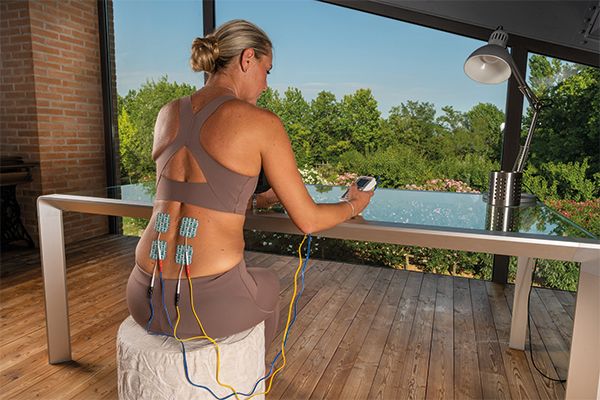
Are there any contraindications or side effects?
In general, the contraindications of electrostimulation are those common to all instrumental therapies, including use during pregnancy, in cases of acute inflammation, and in cases of neoplasm, or abnormal tissue growth.
In particular, you should not use an electrotherapy device:
- On cancerous lesions in the treatment area
- On infected, swollen or acutely inflamed areas
- On skin rashes (phlebitis, thrombophlebitis, etc.)
- On open wounds, dermatitis, or skin inflammation
Furthermore, its use is prohibited with:
- Pacemaker users
- Cardiac patients
- Sufferers of severe arrhythmia, and epileptic patients
- Pregnant women
- Acute anxiety sufferers
- People with serious illnesses, such as tuberculosis, juvenile diabetes, viral diseases (in acute phases), inguinal mycosis and abdominal hernias
- Magnetisable prosthesis users
We recommend that you go ahead with an electrotherapy treatment only if the cause of pain is known, and only after consulting a specialist medical practitioner.
Possible side effects, on the other hand, mainly relate to:
- Overtraining, if guidelines are not properly followed
- Possible skin redness under the electrodes, particularly if the electrodes are worn out or a cream has been used before applying the electrodes.
Is electrostimulation painful?
It is normally considered a painless technique. However, if you are not yet used to it and do not use the device properly, you may experience a slightly unpleasant sensation during the first few sessions. But don’t worry, if you carefully follow the instructions in the device’s user manual, this shouldn’t happen.
If you are using an electrotherapy device for the very first time, we always recommend you start with a programme, such as a mild toning one, that does not demand a huge commitment. Furthermore, we advise you to increase the intensity gradually, starting with a low current intensity that is pleasant, or at least not painful, and progressively increasing the intensity over subsequent sessions, without ever exceeding your pain threshold.
Each different type of current will create a different sensation on your skin and in your muscles. In the case of a TENS treatment, the sensation should be a pleasant tingling. Visually, you won’t see any contraction of your muscles. The sensation should also be very similar when using a direct current on an iontophoresis, or transdermal drug delivery, programme.
On the other hand, the programmes are somewhat different for rehabilitation and sports use. When following an EMS or FES programme, you will see the muscle contract at different intervals, and the sensation will be that of some pressure applied to the muscle, which, however, should not cause any pain. The sensation is also similar on an incontinence programme, with the electric current applied internally using special probes.
Electrostimulation results: before and after
Electrostimulation is an effective therapeutic method that can give extremely satisfactory results in many cases, which, however, can be quite complex to quantify without special evaluation tools. At a home or amateur level, photographic comparisons can be made to evaluate muscle tone every 10 electrostimulation sessions or so, while, for sports and training, field tests can be carried out to evaluate the increase in strength related to the use of electrostimulation.
Who can use electrostimulation?
Muscle electrostimulation is a treatment for everyone, except only contraindicated cases.
Our 2 or 4 channel home devices have been designed to be intuitive, safe and portable. In certain cases, depending on the pathology you have been diagnosed with, you may, under the guidance of a physiotherapist, use an electrostimulator during specific physical exercises.
The limitations of electrostimulation are related, except for specific treatments requiring the use of drugs, for example, to the pathologies being treated or to the rehabilitation phase in which surgery is performed.
Can electrostimulation be used to lose weight or improve sports performance?
Electrostimulation is highly appreciated as a support for technical and physical sports training.
In particular, with adequate use of specific programmes, you can increase boost both muscular strength and endurance.
The electrical pulses generated by an electrostimulator are transmitted to muscles via the peripheral nervous system, and marginally involve the central nervous system. It is therefore advisable to increase coordination training in order to make the most of the advantages in terms of strength obtained with electrostimulation, to ensure that the central nervous system is able to optimally manage these performance boosts, and make them available during sports practice.
Can electrostimulation be used to lose weight?
There are two aspects to consider here. The first is closely related to the energy consumption induced by electrostimulation. The second is related to the metabolic and anabolic effects induced by muscular activity, regardless of how it is triggered.
Since muscles need energy to function, electrostimulation is able to achieve this result, but to lose weight effectively the increase in energy consumption must be significant.
Therefore, from this point of view, it is advisable to carry out aerobic exercise (even just a walk outside) to increase your energy consumption more effectively. Electrostimulation can be used to support an increase in muscle tone and energy consumption in specific areas, and therefore optimally localize the weight loss effect.
How can you choose the best electrostimulator for your needs?
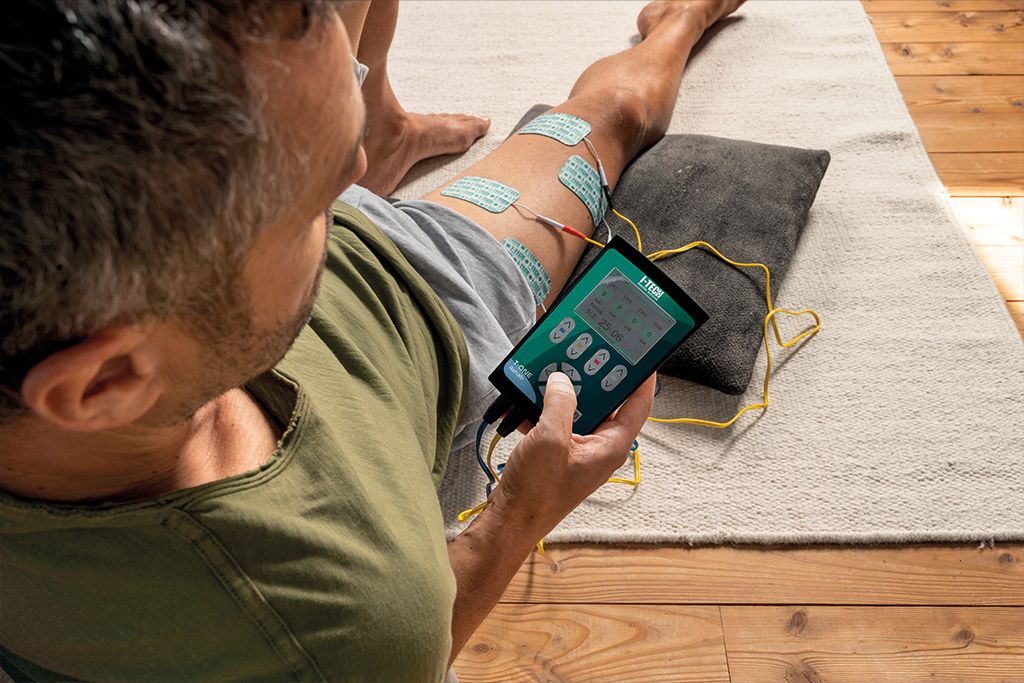
The first rule is to choose an electrostimulator according to the programmes it has to treat the pathology you have been diagnosed with. In any case, you should always make sure that it is a certified medical device.
Not all devices on the market emit all the specific currents mentioned in the previous paragraphs. This is why the help of your doctor is essential in understanding the right therapy to use.
Secondly, you need to identify how many muscle groups you need to treat. This will help you decide between, for example, a 2 or 4 channel model. In fact, according to the number of channels, you will be able to treat 2 or 4 muscle groups with the same programme.
Our line of home devices is extremely extensive and can meet any need. Among our 2-channel devices, you can choose from:
I-Tech Physio
The most complete 2-channel electrostimulator that also allows you to carry out denervated muscle treatments.
Features Transcutaneous Electrical Nerve Stimulation (TENS), Neuromuscular Electrical Stimulation (NEMS), REHAB, BEAUTY and INCONTINENCE programmes.
Price of 329,00 € (VAT included)
If, however, you want a more specific model for purposes such as transdermal drug delivery (iontophoresis) or incontinence, you can choose from:
Mio-Peristim
Dedicated to and specifically designed for problems related to male and female incontinence. It is sold with a special anal and vaginal probe to use in carrying out the treatment.
It also features Transcutaneous Electrical Nerve Stimulation (TENS) programmes.
Price of 269,00 € (VAT included)
All the 2-channel models reach a maximum intensity of 100 mA per channel.
If, however, you are looking for a more complete, higher-performance model (with a maximum intensity of up to 120 mA), capable of treating 4 muscle groups simultaneously, you should choose from the 4-channel line:
11 medical device models, designed for every need, all with CE marking certification.
Do I necessarily have to choose a professional product?
You don’t have to choose a professional product. As already mentioned, even a device for sports or fitness use, which is CE and medical product certified, is an equally valid product.
The characteristics that differentiate a home use electrostimulator from a professional model are the absence of certain programmes that require specific training, or certain features that are only useful to particular users. This is without considering that a professional electrostimulator should be operated by a professional, following a specific therapeutic process, at a professional therapy centre.
As mentioned previously, the choice between a 2 or 4 channel model is up to you. However, a 4-channel electrostimulator allows the stimulation of multiple muscle groups at the same time, and can be more effective in the stimulation of larger muscles, including quadriceps, abdominal muscles and the buttocks.
Home electrostimulators are designed and certified to be used independently, in the comfort of your own home. They are simple to use, even by those less adept at using technology.
Where can you buy our electrostimulators?
Our electrostimulators are sold by over 2,000 retailers throughout Italy. They are also available at healthcare and orthopaedic facilities and pharmacies. To find the point of sale closest to you, visit our web page, and, if there’s no reseller near to you, contact us directly by web form, phone, e-mail or any of our social media channels.
What’s more, many of our models can also be purchased online.
In short, you are spoilt for choice!



